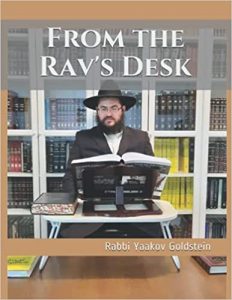

*As an Amazon Associate I earn from qualifying purchases.
- Question: [Sunday, 7th Shevat, 5782]
I had recently sent my tefillin to be checked and when they returned with a kosher verification from the Sofer I noticed that one of the corner sinews which tie the Bayis was loose and came out of its groove and is now resting on the side of the Bayis. Is there any issue with this?
Answer:
Absolutely. The tefillin is possibly invalid until the sinew is resewed and tightened back into its place within the groove. First, you should make sure to borrow someone else’s tefillin until this is fixed. Second, you should call the Sofer and inform him of the issue, and have him resew the tefillin.
Explanation: It is a tradition from Moses on Sinai that the sewing of the sinews by the Bayis of the tefillin must be an exact square, otherwise it is invalid. Thus, if the sinew has moved out of its place in the square the question is raised as to whether the tefillin is invalid, being that it is no longer square. While this seems to be the logical conclusion, the only issue with this is that in the discussion in the Poskim regarding if the stitches tear, and the various cases of validation, no mention is made regarding the fact that the squareness of the stitching gets ruined when even a single stitch two years. The Maharam Shick addresses this issue and concludes that the Tefillin remains Kosher as the squareness of the stitches is not an invalidating factor. However, the Biur Halacha also addresses this issue and concludes with a Tzaruch Iyun, as in truth the squareness of the Tefillin is an invalidating factor, and so is clear from Admur that the squareness of the stitching is absolutely necessary to validate the Tefillin, and if it gets ruined then it must be fixed, and until it is fixed the Tefillin are Pasul, unlike the conclusion of the Maharam Shick. Practically, based on what the Biur Halacha explains there, if the tear occurs in the corner, then it is more severe as there is no longer a corner connection to make the square. Certainly, this applies if the string does not tear at all but simply comes out of the groove in which case the squareness is ruined. Hence, in your case that the sinew came out by the corner area of the sewing one is to certainly be stringent to consider the squareness to have been invalidated, and have it fixed as soon as possible. Furthermore, one can argue that having the sinews move out of their groove is more stringent than having them tear from the respect of the lack of squareness, and that therefore one should be stringent even if this occurs in the center, and not by the corner area.
Sources: See regarding the requirement if this occurs in the center for the stitches of the sewing to be a square: Admur 32:59; Michaber 32:39; Rav Papa Menachos 35a as explains Rosh [unlike Rashi]; Elya Raba 32:59; See P”M 32 M”Z 33; Kol Yaakov 32:175; M”B 32:174; Biur Halacha 32:39 “Sheyiyu”; See Piskeiy Teshuvos 32:64 for the full details of this matter and of how this square shape is to be accomplished; Inside Stam p. 286 See regarding the law if the stitches of the sewing tore: Admur 33:2 and Michaber and Rama 33:2; See there for the various cases and the law of new Tefillin versus old Tefillin and if there is a difference regarding how many dividers tore; See Menachos 35a; See Piskeiy Teshuvos 33:2; See regarding the invalidation of squareness when the stitches tear: Maharam Shick O.C. 18 who says that the squareness of the stitching is not an invalidating factor and hence rules in the above that the Tefillin is valid Bedieved even if the Tefillin tears in the corner; Admur ibid 32:59 who rules the squareness of the stitching is an invalidating factor; Biur Halacha 33:2 “Lachush” “In my opinion, the entire law of torn strings requires deep analysis, as we rule that also the stitching must be a square according to the tradition of Moses on Sinai, and that if it became ruined and must be fixed, and therefore when three stitches tear it should be invalid even according to Rambam being that the squareness is ruined. Certainly, if the tear occurred in the corner, then it should be invalid even if only one string tears. Why then do none of the Poskim make mention of this, which implies that they will that it remains valid even in such a case? This entire matter needs further analysis.”; Piskeiy Teshuvos 33:2 footnote 17 concludes that although it should be fixed, it may be worn with a blessing until it is fixed even if this occurs in the corner; Sefer Tefira Tama 7:1-2 concludes that if the tear is in the corner that is invalid, and if the tear is in the middle then it is valid although still proper to be fixed; Sefer Zivcheiy Tzedek [Diskin] Bo p. 13


Leave A Comment?
You must be logged in to post a comment.